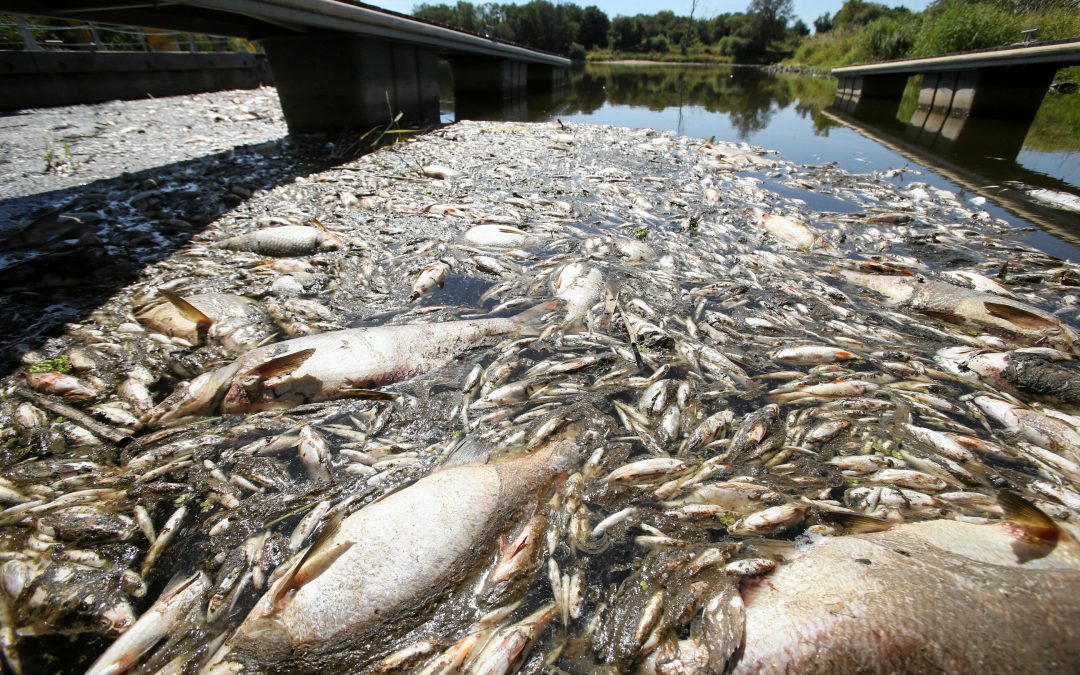By Wojciech Kość
The plight of the poisoned Oder – Poland’s second longest river, much of which forms the border with Germany – has dominated the news since early last week.
But while the scale of the disaster is enormous – with tonnes of dead fish now reported along most of the river’s length – the public remains in the dark as to the causes and possible long-term impact. Here’s a summary of what we know so far.
What happened?
While details are murky, the tragic end result is crystal clear: the Oder has suffered a major environmental disaster, resulting in over 80 tonnes of dead fish being hauled out of the water and the authorities issuing a ban on entering the river and using its water for any purpose.
The rebuilding of the ecosystem will take years, if not decades, say environmentalists.
For more on the apparent poisoning of the Oder river in Poland, which has left thousands of fish dead, see our report:https://t.co/iWnH8QVgMw
— Notes from Poland 🇵🇱 (@notesfrompoland) August 12, 2022
Where and when did the disaster occur?
Around 27 July, local anglers in the town of Oława observed dead fish in a lock on the Oder and linked their presence to earlier reports – from around mid-July – of similar sightings not far up the river, near the junction of the Oder and the Gliwice Canal, an artificial waterway linking the industrial region of Upper Silesia with the now-poisoned river.
Since then, however, the regional environmental inspectorate in Katowice and the regional Gliwice branch of Wody Polskie – the state manager of Poland’s waters – have denied that the incident in the canal and the fish die-off in the Oława had the same underlying cause.
Meanwhile, what began to look clearly like a toxic wave continued to flow downstream, with reports of dead fish multiplying from ever more locations. On 5 August, the pollution reached Głogów; on 9 August, Krosno Odrzańskie; then on 10 August, Kostrzyn nad Odrą, a town early on the section of the river that Poland shares with Germany.
A map showing where thousands of dead fish have been found in the Oder river in Poland over the last two weeks, with suspicions that hazardous waste has entered the water.
It is a “catastrophe” that will have a wider impact on the environment, say experts https://t.co/BmW6Q29sJ7
— Notes from Poland 🇵🇱 (@notesfrompoland) August 11, 2022
By 12 August, the disaster had reached the Lower Oder, which only heightened the worries of environmentalists, as the region is a particularly valuable area in the river’s valley (more on that below).
The authorities have since put up barriers to stop dead fish from going further downstream.
What happened exactly?
This is the key question to which there is as yet no answer, despite the disaster having unfolded for nearly three weeks now. Early water samples did point to mesitylene poisoning, but that is yet to be confirmed or ruled out definitively. There are still no other details of the water samples taken by the Polish authorities (they are expected on Tuesday at the earliest, as Monday is a holiday).
Poland has denied earlier claims reported by the German media that the samples taken by the German environmental services contained mercury.
“We received official water test results from the German side. No mercury was found. Analyses on both sides of the border point to high salinity. Comprehensive toxicological studies are underway in Poland,” Poland’s climate and environment minister Anna Moskwa tweeted on 13 August.
Otrzymaliśmy oficjalnie od strony niemieckiej aktualne wyniki badań wody. Nie stwierdzono obecności rtęci. Analizy po obu stronach granicy wykazują wysokie zasolenie. W Polsce trwają kompleksowe badania toksykologiczne. Poinformujemy o kolejnych wnioskach
— Anna Moskwa (@moskwa_anna) August 13, 2022
Axel Vogel, the environment minister of the German state of Brandenburg, offered more nuance on 15 August, as he reportedly told a press briefing in the town of Lebus that “mercury accumulates slowly and was not introduced into the Oder in such a dimension that it could have triggered these deaths immediately”.
The abnormal salinity – which measurements from the German monitoring station in Frankfurt (Oder) point to – is an environment in which toxic cyanobacteria could flourish, says Sebastian Szklarek, a hydrologist.
“If the problem began downstream from the Gliwice Canal – which runs through some of Poland’s most heavily industrialised areas – then it could have originated after somebody – an industrial company or a mine – discharged vast amounts of highly salinated water. That could have led to the flourishing of cyanobacteria,” says Szklarek.
The expert adds that reports of skin irritation – a typical symptom of coming into contact with cyanobacteria – in people working in the Oder to clean it of dead fish make the hypothesis even more likely.
Has there been a political fallout?
Yes, although not to the extent that would match the public outrage about the disaster. Environmentalists, the opposition, as well as some local residents along the Oder accuse the government and its agencies of sitting waiting far too long after the first reports of fish dying between the Gliwice Canal and Oława in late July.
The agencies involved – mainly the General Environmental Protection Inspectorate (GIOŚ) and Wody Polskie – have sought to refute the accusations by publishing documents or statements claiming they took action already in late July.
Still, the facts are that – whatever caused it – the toxic wave flowed for much of the Oder’s length and reached the valuable Lower Oder region, the Oder’s estuary into the Szczecin Lagoon (Zalew Szczeciński) and the city of Szczecin.
On Thursday, a botched press briefing by Jacek Ozdoba and Grzegorz Witkowski – deputy environment and infrastructure ministers respectively – saw angry locals shout down the officials, who tried to convince them that the situation was under control.
@GWitkowski82 wszedł pan w końcu do tej Odry? pic.twitter.com/zir0sbZDf6
— Dominik Szczepanski (@deszczep) August 12, 2022
Public pressure has worked to an extent. “We want to find those guilty of this scandal, this ecological crime on a huge scale, and punish them as severely as possible!” Prime Minister Mateusz Morawiecki wrote on Facebook on 12 August.
He then fired the head of Wody Polskie, Przemysław Daca, and the head of GIOŚ, Michał Mistrzak, saying that the response to the disaster “could have been faster”.
The government also said that a reward of one million złoty (€215,000) is on offer for tipping authorities off about who is responsible for the disaster.
Police in Poland have offered a one million zloty (€215,000) reward for information that helps identify the cause of contamination of the Oder river, which has resulted in thousands of fish dying and raised fears of a larger environmental catastrophe https://t.co/MQ2JNssQ1n
— Notes from Poland 🇵🇱 (@notesfrompoland) August 13, 2022
What do the Germans say?
Early into the crisis, the government of the German state of Brandenburg accused Poland of failing to trigger communication protocols and inform the German side of an ongoing crisis on the Oder. Since then, Moskwa has met with her German counterpart Steffi Lemke to discuss the situation and ways of remedying it.
“We have agreed to ensure a close exchange of information between the Polish and German sides. We agree that the priority now is to limit the damage, protect the population and identify the cause and the potential perpetrator. This environmental crime must be solved,” Lemke said after meeting Moskwa on 13 August.
Ich werde mich gemeinsam mit @Vogel_Axel für die Aufklärung dieses Verbrechens einsetzen. Den Brandenburger Behörden und allen, die mit Hochdruck an der Aufklärung und Begrenzung dieser Katastrophe arbeiten, danke ich wirklich sehr für ihren Einsatz.
— SteffiLemke (@SteffiLemke) August 12, 2022
That said, Lemke told RBB24, a German broadcaster, on the following day that “you shouldn’t try to turn rivers into waterways or sewers”, a swipe at Poland’s plans to make the Oder navigable for goods transport.
“It is certain that German-Polish cooperation did not work in this case. The German side was informed much too late,” Lemke added.
What’s at stake for the environment?
The Oder is, environmentally speaking, valuable as a whole – with Natura 2000 and other forms of nature protection covering much of its length in the Czech Republic (where the river originates), Poland, and along the Polish-German border.
Of particular value is the Lower Oder, an area extending from the towns of Cedynia and Schwedt down to the river’s discharge into the Szczecin Lagoon. It is covered by Germany’s Unteres Odertal (Lower Oder) National Park and by Poland’s Landscape Park of the Lower Oder (Park Krajobrazowy Doliny Dolnej Odry).
The Lower Oder is where the river separates into two concurrent streams between which there lies a maze of old canals, oxbows, polders, and wetlands – all home to rare species of birds and other fauna.
A toxic substance, or substances, entering the mostly still water of the Lower Oder system would devastate it, environmentalists say.
Will lessons be learned?
Activists say that the disaster on the Oder is not just a single case of some industrial plant possibly discharging toxic waste into the river. It is the result of years of disregard for the river’s environment.
“It’s far more complex, no matter how much we’d like to pinpoint a single culprit,” says Marta Jermaczek-Sitek, a biologist who has recently moved to a house near the Oder east of the city of Zielona Góra.
“Water parameters in the Oder have been improving lately…yet people regularly raised alarm over illegal discharge of industrial wastewater. The discharges would typically become diluted but the Oder is very low this year,” she adds.
Indeed, a hydrological map of Poland by meteorological service IMGW – which publishes data from water level-measuring stations – shows the Oder’s course dotted with black triangles indicating low water levels.
Jermaczek-Sitek adds that any works in the river that might have stirred up sediment could have added to the deadly pollution.
“We don’t know all the details but we can sum the whole situation up: the river simply broke down,” says the biologist. “The river’s capacity for self-regulation and self-cleaning reached its limit and an ecological bomb was set off.”
The government is meeting on Tuesday to discuss harsher penalties for polluting rivers, Morawiecki announced today in Uraz, another town on the Oder that was affected by the disaster.
But the opposition was quick to point out that parliament – including the prime minister – had already voted to increase penalties for causing environmental damage, as recently as 22 July.
Main image credit: Cezary Aszkielowicz / Agencja Wyborcza.pl





















